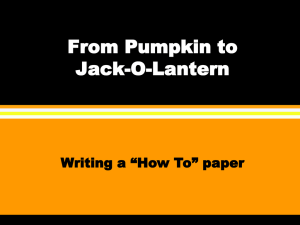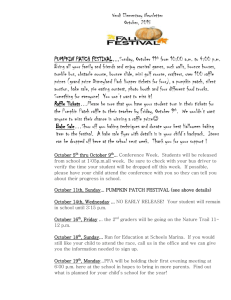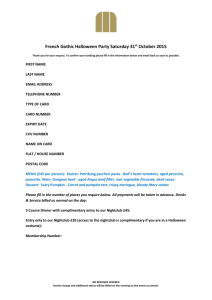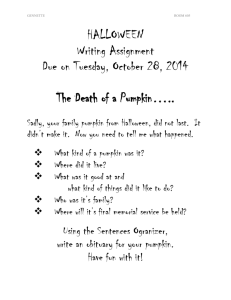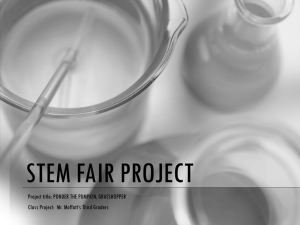Activity
advertisement
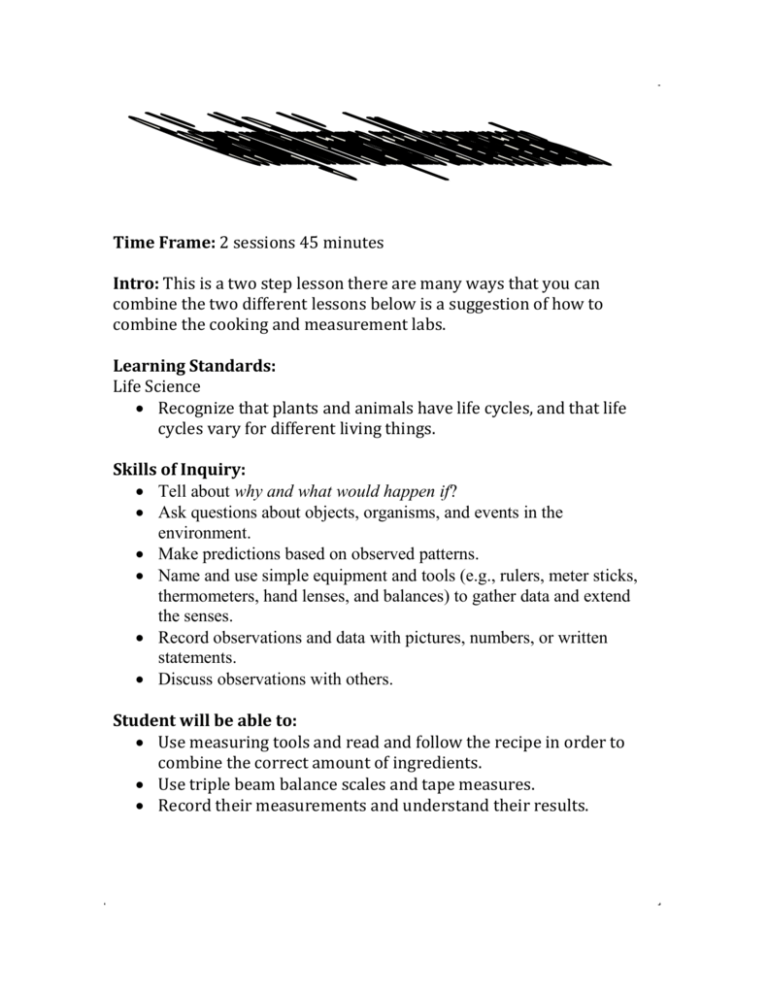
Time Frame: 2 sessions 45 minutes Intro: This is a two step lesson there are many ways that you can combine the two different lessons below is a suggestion of how to combine the cooking and measurement labs. Learning Standards: Life Science Recognize that plants and animals have life cycles, and that life cycles vary for different living things. Skills of Inquiry: Tell about why and what would happen if? Ask questions about objects, organisms, and events in the environment. Make predictions based on observed patterns. Name and use simple equipment and tools (e.g., rulers, meter sticks, thermometers, hand lenses, and balances) to gather data and extend the senses. Record observations and data with pictures, numbers, or written statements. Discuss observations with others. Student will be able to: Use measuring tools and read and follow the recipe in order to combine the correct amount of ingredients. Use triple beam balance scales and tape measures. Record their measurements and understand their results. Materials: Big pumpkin wax paper (to put seeds on) spoon (to clean out pumpkin) little pumpkin per student tape measurers triple beam balance scales. Anticipatory set (on rug): Present the students with a large pumpkin. Explain to them that this pumpkin grows off of a pumpkin plant and in turn the plant grows from a pumpkin seed. Ask the students if they know where the pumpkin seeds are. Cut the pumpkin open and allow the students to look inside. Have each student estimate how many seeds are in each large pumpkin. Record their guesses because you will be counting the seeds next lab. 1. 2. 3. 4. 5. Activity (start on rug): Scoop out seeds and put them somewhere to save for next class. You can either let the students scoop out the insides of the pumpkin or do this yourself. You should remove all the stringy material and seeds from the inside of the pumpkin. Then cut the pumpkin into a couple slices and cook it. You can either use microwave or stovetop. For microwave put pumpkin in a bowl with a couple inches of water and microwave. You should cook until pumpkin is soft. Note that the cooking should probably be done at home. Once cooked, put the pumpkin in the fridge to save for next week’s class After pumpkin is cleaned out, show the students how to use a triple beam balance scale. 6. Allow the students to go sit down at their tables there should be a small pumpkin at each spot and tape measurers and scales at each table. Teachers should be spread out around tables to help out and stimulate questions. 7. The students should use the tools at hand to fill out the attached worksheet. Teachers should walk around and assist the children in using the scales. Closure: Tell the students that next class they will be making pumpkin pie with the pumpkin they have just cut. Assessment: Participation in class discussion and activities. Materials: four pie crusts four measuring cups and teaspoons pumpkin from last class (bring canned pumpkin just in case) sugar ground cinnamon ground nutmeg salt ground ginger ground cloves or allspice 8 eggs (2 per group) four mixing bowls and at least four big spoons to mix ingredients. (Recipe from Joy of Cooking is attached on back) Vocabulary: Anticipatory set: Ask students if they remember what they did last week in lab. Present the different measuring tools (cup and teaspoon) and quickly explain how to use them. Tell the students that as a team they must combine the correct amount of ingredients to make their pie. Activity: 1. At each table there should be all the appropriate ingredients and measuring tools. Put the attached list of simplified directions at each table so that the students must follow written directions to make the pie. Each table should also have a pre-made piecrust. 2. The students should be split up into four groups and each group should be responsible for making their own pie. 3. Teachers should walk around room making sure that all students are contributing and measurements are being taken carefully. 4. Once the ingredients are mixed, the students should pour mixture into crust and the teachers should take the pies to be cooked. 5. While the students are waiting for the pie to cook they should count the pumpkin seeds. Give each group a clump of seeds from the pumpkin they cut open last class. When each group has counted their clump of seeds, have the students add up the seeds to find the total amount of seeds in the pumpkin. Closure Look at the list of estimations and determine which student was closest to the actual number of seeds. Were most people pretty close? Assessment: Participation in class discussion and activity. Ability to accurately measure and combine ingredients.
